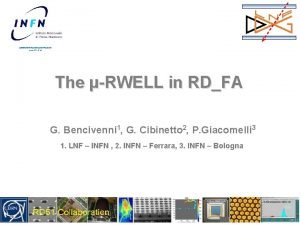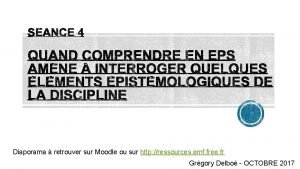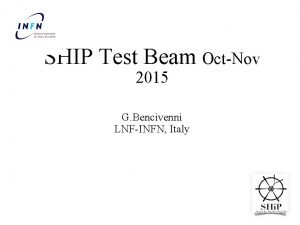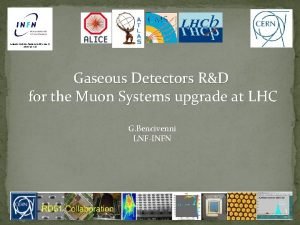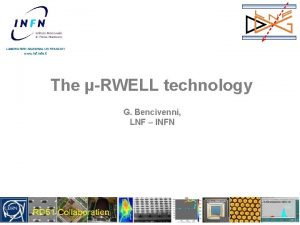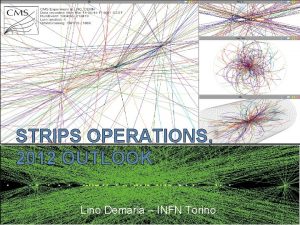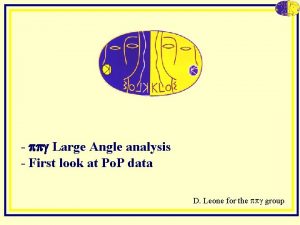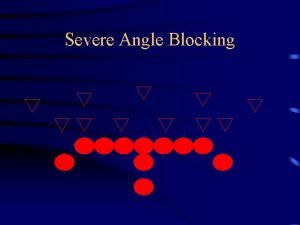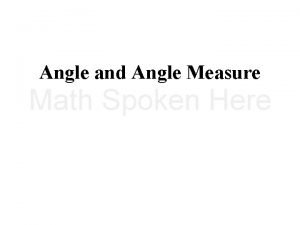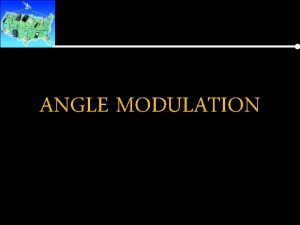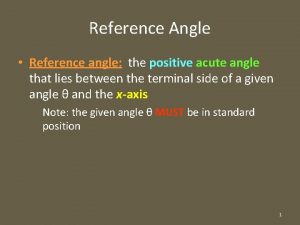Update of ppg at large angle LNF 20022004













- Slides: 13

Update of ppg at large angle (LNF 20/02/2004) See: C. Bini, S. Ventura C. Bini, B. Di Micco KLOE Memo 284 KLOE Memo 285 (1) Results of the fit (2) Forward-Backward asymmetry (3) Upper limit on h p+p-

(1) Results of the fit N(Q) = K [ FISR(Q, Mr, Gr, a, b) + FFSR(Q) + Ff 0(Q, gf. KK, R, mf 0) FINT(Q) + g. Frp(Q) + d. F 3 p(Q) ] K = fcoll(Q) e(Q) L b fcoll(Q) = correction for collinear radiation (EVA) e(Q) = efficiency L = integrated luminosity (349 pb-1) b = bin size (1. 2 Me. V) Results stability checked vs. : Bin size (1. 2, 2. 4, 6. 0, 12. 0 Me. V) First point (280 to 660 Me. V) Last point (996 to 1015 Me. V)

rp background: f r p , r p g - Achasov param. - PDG abs. normalisation g - No interference (? ? ) 3 p background (surviving the cuts): f p +p -p 0 - MC based abs. normalisation d

- interference no interference + interference

Table with fit results: compare the 3 hypotheses; for fit 0 hyp. stability estimate (second error) Fit- Fit 0 Fit+ c 2 / 481 755 597 750 g 2 f. KK/4 p (Ge. V 2) 1. 52 0. 13 0. 98 0. 07 0. 16 0. 28 0. 02 R 1. 69 0. 15 7. 83 0. 32 0. 50 6. 9 0. 6 Mf 0 (Me. V) 934 4 980. 6 0. 4 0. 6 992. 1 0. 6 Mr (Me. V) 774. 3 0. 2 773. 6 0. 2 0. 8 773. 4 0. 2 Gr (Me. V) 145. 3 0. 5 144. 6 0. 3 1. 2 145. 4 0. 3 a ( x 10 -2) 0. 169 0. 005 0. 176 0. 005 0. 008 0. 191 0. 015 b -0. 129 0. 005 -0. 115 0. 002 0. 004 -0. 094 0. 007 g < 0. 2 <0. 16 <0. 11 d <0. 06 0. 31 0. 08 0. 30 0. 06 G(f 0 p+p-) (Me. V) 230 30. 6 9. 8 BR (6. 6 0. 6) x 10 -5

Attempt to fit “forcing” f 0 p 0 p 0 KLOE parameters: Fit no s Fit 0 c 2 = 3700 Fit s g 2 f. KK/4 p (Ge. V 2) 1. 29 2. 79 R 3. 22 4. 00 Mf 0 (Me. V) 962 973 Fitc 2 = 1313

f 0 p+p- after subtraction (red) vs. f 0 p 0 p 0 “raw” spectrum (blue) 2 possible explanations: (1) p 0 p 0 g spectrum has “another contribution” (2) p+p-g has “another interference scheme”

(2) Forward-backward asymmetry p+p- system: odd terms (green) and even terms (brown) A(ISR) C-odd A(FSR) C-even A(f 0) C-even |A(tot)|2 = |A(ISR)|2 + |A(FSR)|2 + |A(f 0)|2 + 2 Re[A(ISR) A(FSR)] + 2 Re[A(ISR) A(f 0)] + 2 Re[A(FSR) A(f 0)] Asymmetry in p+ p- q angle (depending on the cuts)

The integrated FB-asymmetry is (two definitions):

Comparison with MC: Eva + Geanfi reconstruction: (red) data (triangles) MC gener. (open circles) MC recon. data-MC discrepancy below 700 Me. V Clear f 0 effect Data > MC between 700 and 900 Me. V

f 0 signal in M(pp) spectrum and in FB asymmetry

(3) Upper limit for h p+p Expected signal: Gaussian m = 547. 3 Me. V s = 1. 33 Me. V Ns = -22 24 Ns < 21. 1 (90%C. L. ) Nh = 1. 43 107 (from 3 p 0 counting) BR( h p+p-) < 8. 9 10 -6 Comments: (1) Factor 37 improvement respect to previous limit (2) The negative fluctuation helps !

Conclusions: Perspectives for publication and presentation at conferences: (1) The fit of the M(pp) spectrum is in “final shape”; (2) The FB-asymmetry reinforces the f 0 signal BUT does not add any further insight: needs “theoretical support”. (3) The upper limit is also in “final shape”: discussion on the way to extract the limit are welcome.


